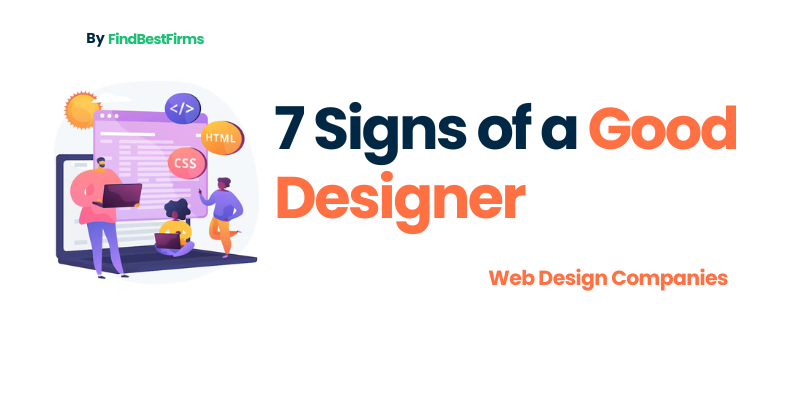Why Recognizing a Good Designer Matters
The digital world thrives on visuals, and behind every captivating website or stunning graphic lies the skill of a talented designer. Whether you’re working with a freelance web designer or a team from one of the top web design companies, recognizing the signs of a good designer can make or break your project. A skilled designer ensures that your brand’s story is conveyed effectively, creating a strong impact on your audience. In this blog, we’ll discuss the seven critical traits that distinguish great designers from the rest, helping you make informed decisions when hiring one.
1. Strong Visual Communication Skills
Understanding Audience Needs
A good design is all about effective communication with a target audience. A professional designer does not think solely of beauty but also the psychology of the intended audience. For instance, a proficient web designer working in a small business understands that it is often easier for users to connect and empathize with simple yet clear designs rather than flashy ones.
Simplifying Complex Ideas
Among the many responsibilities of designers, simple explanations of complex concepts come forth. A good web designer makes difficult data or a multi-layered concept presentable, clean, and digestible in visual format. For instance, offering clear and intuitive product categories for an e-commerce website is one effective way of improving user experience.
2. Creativity and Originality
Unique Problem-Solving
The best designers are innovative problem solvers. They do not borrow other trends; they innovate to provide solutions specific to a challenge. For example, if one intends to create a unique brand identity, then a creative designer ensures that it stands out within the scope of what the company is trying to accomplish.
Innovative Thinking
It is not just the creation of something new but more so about its importance. Innovative designers, especially the best web design companies, continually evolve new ideas by putting modernism in functionality. They bring forth new ideas to the table so that their designs may stay relevant and competitive as time goes on in this ultrafast-evolving digital landscape.
3. Attention to Detail
Precision in Design Elements
A good designer understands that even the smallest design element matters. Be it the alignment of text, the shade of a color, or the spacing between elements, everything contributes to the overall look and feel of the design. For instance, when designing a website, precise attention to margins, fonts, and layouts can be the difference between professional and amateurish.
Consistency and Cohesion
Consistency is the hallmark of professionalism. A good web designer ensures that branding elements such as color, typography, and imagery are the same across all platforms. This uniformity solidifies the brand’s identity and has them providing a seamless experience to the end users-that is why top designers are in such demand by e-commerce or SaaS firms.
4. Technical Proficiency
Software Mastery
A modern web designer must have proficiency in tools like Adobe Photoshop, Illustrator, Figma, and more. Mastery of these tools allows them to create visually stunning designs. Furthermore, designers from web design firms are often skilled in coding languages like HTML, CSS, and JavaScript, enabling them to collaborate effectively with developers.
Up-to-Date with Trends
Design trends change pretty fast, and it is totally non-negotiable to keep abreast of the latest techniques- from micro-interactions to dark mode designs or minimalist aesthetics, so that the output coming out from this designer could resonate with the expectations of current users.
5. Receptive to Feedback
Open to Criticism
Even the most professional web designer needs to hear constructive criticism. Willingness to listen to client comments speaks volumes of humility, a quality requisite in producing the best end product. Whether a freelancer or a group of designers, one needs to be agile and accommodating to ensure that the project serves the intended expectation of the client.
Iterative Improvement
Revisions are an inevitable part of any design process. Good designers embrace this as an opportunity to refine their work. Through collaboration with clients and teams, they produce polished results that meet both creative and business objectives. This iterative approach is often a defining trait of designers from top web design companies.
6. Strong Time Management Skills
Punctual Delivery
Design projects often run on tight schedules, making punctuality essential. A good designer ensures that deadlines are met without compromising the quality of their work. This is particularly critical for businesses launching time-sensitive campaigns or products.
Prioritization
Balancing multiple projects is a common challenge for designers. A top-tier web designer knows how to prioritize tasks, delivering high-quality results on time while managing multiple client demands effectively.
7. Empathy and Understanding of Client Vision
Customer-Centric Approach
Empathy is at the core of good design. A skilled designer actively listens to clients, understanding their goals, target audience, and overall vision. For instance, when creating a website for a startup, a designer must balance the client’s limited resources with the need for impactful branding.
Bringing Ideas to Life
The ability to transform abstract ideas into visually compelling designs is what sets great designers apart. Whether it’s a logo, a website, or a social media campaign, a good web designer ensures the final product aligns perfectly with the client’s vision, enhancing the brand’s identity.
Conclusion
Choosing a designer can be daunting, but by focusing on these seven signs, you can make an informed decision. Whether you’re hiring a freelance web designer or partnering with one of the top web design companies, recognizing traits like creativity, technical proficiency, and strong communication skills is key to ensuring your project’s success.
Investing in a skilled designer isn’t just about creating visually appealing assets—it’s about building an experience that resonates with your audience and strengthens your brand. As you evaluate potential designers, remember these traits and choose one who can bring your vision to life while adding immense value to your business.

